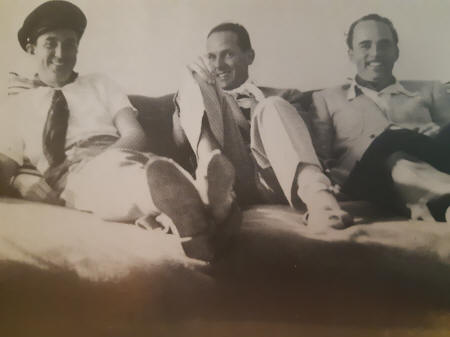

Partner Frank Lysinger
Queer Places:
3652 Empire Dr, Los Angeles, CA 90034
3150 Wilshire Blvd, Los Angeles, CA 90010
Graceland Cemetery
Sidney, Shelby County, Ohio, USA
 Richard Albert Pefferle (January 5, 1905 – March 7, 1969) was an American set decorator. He was nominated for six Academy Awards in the category Best Art Direction.[1]
The design and execution of the 1939's classic The Wizard of Oz was the work
of gay hands. The MGM prop department was presided over by a group of
remarkable men, all gay, from the chief,
Edwin Willis, through the talended
decorators: Richard Pefferle, Jack Moore,
Keogh Gleason,
Henry Grace, and many
others. Pefferle's companion was
Frank Lysinger. "Knowing these men," said Lysinger, "I'd have to say there
was something very inherent about their style and skill. That's why Willis
chose them. He knew they had the most flair. I don't know if that's a gay
sensibility at work or what. But Dick was the only one with formal art-school
training. The others just seemed to come by it naturally."
Richard Albert Pefferle (January 5, 1905 – March 7, 1969) was an American set decorator. He was nominated for six Academy Awards in the category Best Art Direction.[1]
The design and execution of the 1939's classic The Wizard of Oz was the work
of gay hands. The MGM prop department was presided over by a group of
remarkable men, all gay, from the chief,
Edwin Willis, through the talended
decorators: Richard Pefferle, Jack Moore,
Keogh Gleason,
Henry Grace, and many
others. Pefferle's companion was
Frank Lysinger. "Knowing these men," said Lysinger, "I'd have to say there
was something very inherent about their style and skill. That's why Willis
chose them. He knew they had the most flair. I don't know if that's a gay
sensibility at work or what. But Dick was the only one with formal art-school
training. The others just seemed to come by it naturally."
Property chief Edwin Willis was viewed as somewhat arrogant and aloof by his staff, even a bit sadistic, canceling vacations cavalierly at the last minute. His homosexuality was known, but there was little fraternization. Among the rest of them, however, there was a very real brotherhood. "Henry Grace, Jack Moore, Dick Pefferle, and Keogh Gleason shared an office, each with their own desk," Frank Lysinger recalled. "There was always a lot of carrying on. Jack and Henry also shared a house down in Manhattan Beach where they'd have some pretty wild weekends."
Richard Pefferle was born in Sidney, Ohio, the son of Mike Pefferle and Pearl Davis. Pefferle's father, the son of German immigrants, managed an iron foundry; he got Dick a job there and expected him to make a career of it. Richard attended the Dayton Art Institute. When Mike Pefferle died, his wife took the insurance money and sent her only child to France to Study at the Sorbonne. In 1932 he was represented in three interesting illustrations in the November Vogue. At the time Pefferle was a designer for the House of Caldwell of New York.
In New York in 1935, Ed Willis was impressed with a window at Lord & Taylor which had used Greta Garbo's Queen Christina as motif, even borrowing some props from MGM. Inquiring after the designer, Willis was introduced to a young Sorbonne graduate, Dick Pefferle. He hired Pefferle on the spot at $75 a week.
During WWII he served in the Army, Corps of Engineers.
The standing joke around Hollywood was that whenever anyone would ask where to get the best antiques in Los Angeles, they were told the MGM prop department. Most of the studio's antiques, chandeliers, china, crystal, and objets d'art had been assembled by the discerning taste of Ed Willis, Dick Pefferle, Henry Grace, Jack Moore, or Keogh Gleason. "I was fascinated the first time I went into that prop building," remembered Frank Lysinger. "Four floors with some of the most beautiful furniture and antiques. Ed Willis used to go to Europe and buy masses of French, English, and German antiques and chandeliers. But you know, they treated it all rather badly. I remembered there was a pink satin sofa where a cat had her litter. But they figured if they damaged something they had all the experts on hand to fix it."
Pefferle was nominated for six Academy Awards for Best Art Direction: Kismet (1944) Madame Bovary (1949) Annie Get Your Gun (1950) Les Girls (1957) The Wonderful World of the Brothers Grimm (1962) Period of Adjustment (1962).
In 1946, the Coty's new Los Angeles salon opened at 3150 Wilshire Blvd. Daniel B. Cathcart was the designer and Jules Brodeur and Richard Pefferle were decorators of the elaborate sales parlors. Among features of the place were a steel and plastic circular stairway and draperies in combinations of fabric and plaster. Outstanding in the salon decor was the world's largest topaz. This item was a fantastic 136,800-carat gem.
As late as 1968, Dick Pefferle snuck out of a theater while watching The Killing of Sister George when he realized it had a lesbian theme. "I thought how silly that was," Frank Lysinger said. "He was actually afraid someone would see him watching this film and make some kind of connection. Even after suche a long and successful career."
My published books: